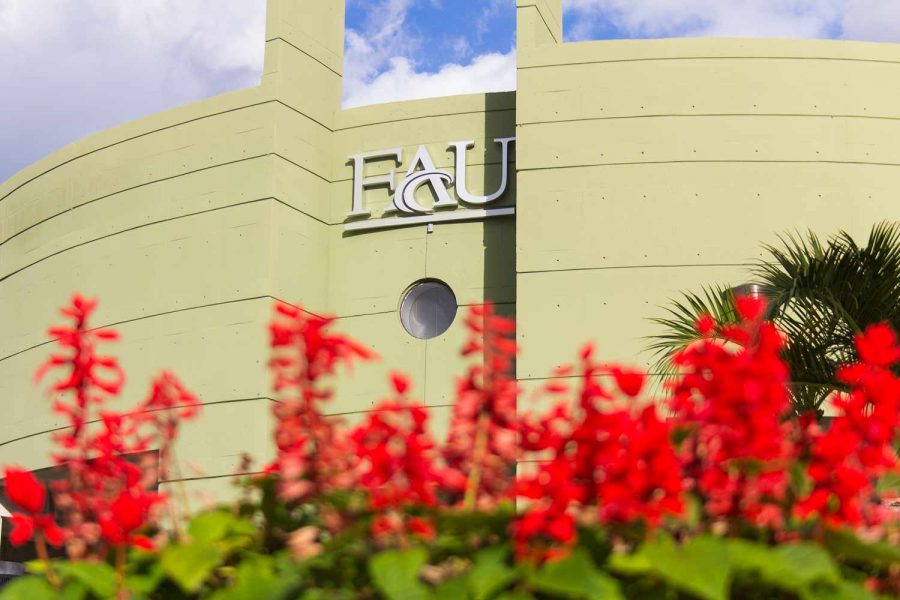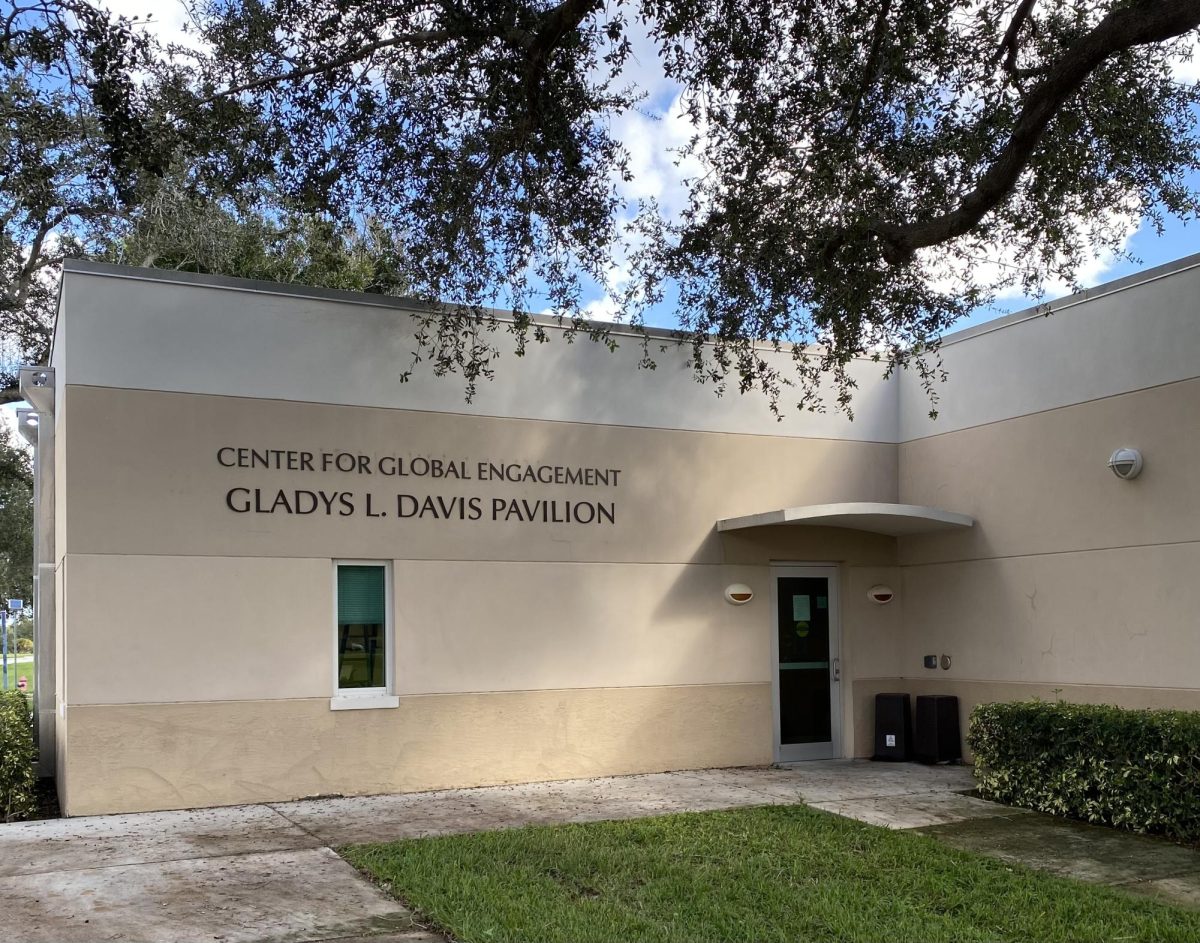When you think of Florida Atlantic football, you probably think of the blue and red stadium with palm trees at the entrances, just 1.8 miles from the beach. Maybe you think of various FAU game day traditions like the Owl walk, tailgating and the swag surf.
FAU has an infant football program compared to other Division I universities like the University of Florida, Florida State University and the University of Miami. According to FAU’s website, they officially started their football program in 2001.
So, who helped FAU football get to where it is today? How did FAU gain its reputation? What were the most important moments throughout the program’s history?
The Howard Schnellenberger Era
In 1998, former FAU President Anthony Catanese wanted to bring a football program to the university and met with legendary coach Howard Schnellenberger to go over his plans, the University Press reported in April 2021.
Schnellenberger won a National Championship as the head coach of the Miami Hurricanes in 1983 and the 1972 Super Bowl with former Miami Dolphins head coach Don Shula as an assistant coach.
Shula coached the Dolphins from 1970-1995. He is regarded as one of the best coaches of all time for winning back-to-back Super Bowls in 1972 and 1973 and having the most wins by a head coach in NFL history with 347.
Schnellenberger took the job at FAU and went off running. He set his mind to doing everything in his power to bring collegiate football to Boca Raton.
Dr. Richard Staller, who is one of the original founders of the FAU football program and is the team dentist, remembers the day Schnellenberger came to the Boca Raton Roundtable in 1998 and pitched the idea of a football team at FAU.
“He came in and he said ‘We are going to bring Division I football to Boca Raton, we are going to have a stadium on campus, we’re going to play bowl games, we’re going to win bowl games, and then we’re going to win the National Title. Time is the only variable,’” Staller said. “A lot of people laughed and I said ‘Why not?’”
Schnellenberger was named the “Director of Football Operations” in 1998 and the following year he was also named the head coach.
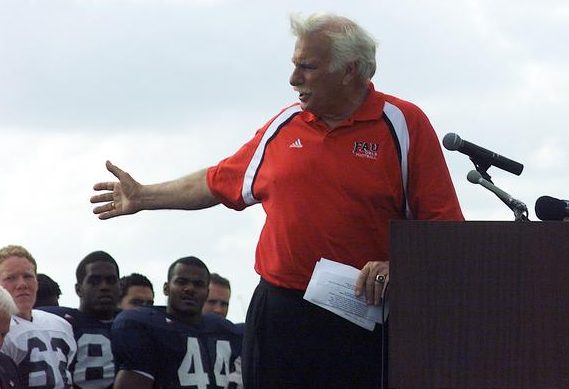
Schnellenberger needed to fill out his roster by 2001, the first year of play for the program. That date was quickly approaching and the program started to recruit players around the state, specifically in the South Florida area.
Practically every recruited player came from South Florida, with only a few exceptions — one being star quarterback Jared Allen, an Oklahoma native.
“So my high school head coach, coach [Brian] Kelly, had sent out all of the film,” Allen said. “They [FAU] had reached out, but I was late in the process, so I didn’t sign my letter of intent until, gosh, a week after signing day. So I was the last recruit of the first class in the year 2000.”
Allen said that the first class didn’t have enough players on the roster so the first recruiting class redshirted and practiced in the year 2000 to get prepared for the 2001 inaugural season.
After dressing up in a small crowded locker room meant for the basketball team, the team took bus rides to the practice fields behind the newly built Tom Oxley Center. During these practices, the team underwent rugged conditions to get ready for the first game taking place in a year.
“They were practicing three times a day,” Staller said. “The games would have been easier than the practices if you played for coach Schnellenberger. [The team was] killing each other, smashing each other…There were no rules, there was no time clock in practice, you just went out and played really hard.”
After a year of hard practice, the moment everyone waited for finally came. The first football game in FAU history. The inaugural game was played at Pro Player Stadium, where the Miami Dolphins played. In fact, this became FAU’s home for the next couple of years.
However, there was a decision to be made prior to the first game, who would be the starting quarterback? FAU signed three quarterbacks in their first recruiting class. Those three were Allen, Garrett Jahn and Mario Fernandez. The decision came down to Allen and Jahn.
“Garrett and I were buddies and we were neck and neck in the battle to be QB one,” Allen said. “We all had a red shirt year…so when we first came there, we didn’t play games. We were battling throughout that time in training camp. Coach called us both in [to his office].”
Schnellenberger told them that a coin flip will decide who started game one. According to Allen, Schnellenberger looked at Allen and said, “Jared, you’re from the farthest away, you’ll call it.”
“I really don’t know exactly what I called, but I didn’t win and Garrett started,” Allen said. “So he got the first half and I got the second half. Then coach [Schnellenberger] was like ‘okay, we’ll just go from there.’”
The day came on Sept. 1, 2001. FAU football’s first official game, where they faced Slippery Rock University, a Division II school from Pennsylvania.
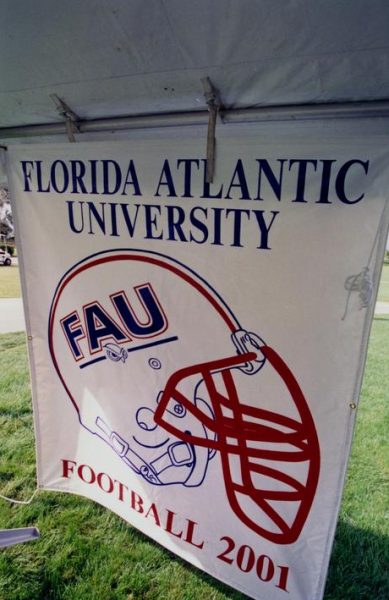
The Owls were in Division I-AA, also known as Football Championship Subdivision [FCS]. They needed to play a few years before they got their shot with the big boys in Division I-A. For the first three seasons of the program, they were at the FCS level.
Unfortunately for FAU, Slippery Rock won the game 40-7. To give more context, FAU was at a severe disadvantage in this game. Thirteen players did not play the first game, which included seven starters, due to them being ineligible. According to Staller, this happened because “the AD [Athletic Director] didn’t know what he was doing.”
Even with the loss, the experience was unforgettable to Allen. “It was unbelievable,” Allen said. “All of the fans were just waiting to have a football team to cheer for. We had 25,000+ people there and it was the whole lower bowl…it was louder than anticipated.”
FAU had a pretty decent inaugural season where they defeated 22nd ranked Bethune-Cookman 31-28 in the 2nd week of their season. Allen had his first start in the victory against Bethune-Cookman and remained FAU’s starting quarterback for the next four seasons. Although FAU ended their first year having a 4-6 record, it was a promising start to the program.
The next year, however, was a disappointment. FAU was 2-9 and the only positive from this season was the first ever Shula Bowl. Florida International University and FAU both created their football programs around the same time. In fact, 2002 was FIU’s first season. Both head coaches, Schnellenberger and Don Strock, had some relation to Shula.
“Howard was big on rivalries [because] rivalries created interest,” Staller said. “So, who else were we going to do? He went after FIU. There was a lot of interest also because of the [Miami] Dolphins…the original coach for FIU was Don Strock [who played quarterback under Shula].”
FAU defeated FIU 31-21 in the first Shula Bowl. Allen was named MVP and defended that title two years in a row until he graduated.
“I think every time, I was just more concerned with getting the win,” Allen said. “I know that is a cliche thing to say, but I just wanted to get the W.” Since 2002, FAU has dominated FIU in the rivalry with a 17-4 record.
The third year in the program’s existence was when the results started to show. FAU went 11-3 and went on a 10-game win streak that helped them get to the FCS Semi-Finals. Unfortunately for FAU, they lost to Colgate 36-24. However, with double-digit wins and a postseason berth, the 2003 season was the first sign of a potentially great program.
To put the cherry on top, FAU received and accepted an invitation to the SunBelt Conference. FAU was now a Division I-A program. Also known as the Football Bowl Subdivision [FBS], the highest level of collegiate football.
“Our belief started to change,” Allen said. “All of the things that he’d [Schnellenberger] been talking about started to become true. We didn’t start seeing the fruits of all of the labor the last two and a half years, until that 2003 season.”
In their first year as an FBS program, FAU went 9-3. This record, however, was a little bittersweet. While it was a great record for such a young program, the team was ineligible for a bowl game since it was their inaugural season at the FBS level.
Including postseason stats, Allen graduated with 8,100 passing yards, 50 passing touchdowns and 26 wins in four seasons, ranking second today in those statistical passing categories in FAU history.
After Allen’s graduation, FAU went 2-8 in the following season and won just five games in the 2006 season.
However, 2006 did bring in incoming freshman quarterback,Rusty Smith. While his first season didn’t impress, his sophomore year showcased another star in the making. Smith put up 3,688 passing yards, 32 touchdown passes and won Sun Belt Player of the Year.
Most importantly, Smith led the team to an 8-5 record. This was enough for bowl eligibility and to be named co-conference champions with Troy University. FAU played the University of Memphis in the New Orleans Bowl and won 44-27, a victory many consider to be the greatest moment in FAU history.
“That was truly the exclamation point of a lot of years of… grassroots football and a lot of fulfilled promises on Howard Schnellenberger’s part,” FAU play-by-play broadcaster Ken LaVicka said.
2008 had a similar story. Smith had another great season, FAU became bowl-eligible and won the Motor City Bowl against Central Michigan University 24-21. In 2009, Smith was playing his last year. He only played seven games before obtaining a sprained AC joint [a shoulder injury] that ended his collegiate career.
FAU dipped below .500 once again, achieving a 5-7 record. Throughout Smith’s entire career, he was a record producer with 10,112 total passing yards and 76 passing touchdowns. These records continue to stand to this day.
Smith’s accomplishments at FAU rewarded him a ticket to the NFL draft where he was selected in the sixth round with the 176th overall pick. This was by far one of the biggest moments in FAU history. Smith was the first football player to be drafted into the NFL, showcasing just how far the football program had come to that point.
“A couple of people run out from what was the founder’s room at the Oxley and said ‘Rusty got drafted, Rusty got drafted,’” LaVicka said. “When Howard found out, I mean, he was like a proud father. After the spring game, he sat and he reflected. Rusty making it, that was the ‘now we’ve made it.’ And Rusty getting drafted opened the door to ‘Oh you come to FAU and you can have an NFL career as well.’”
The next two seasons signaled the end of the Schnellenberger era.While there wasn’t much initial success on the field, most of the success came to the field itself in those final two seasons. Since 2003, FAU had been playing at Lockhart Stadium, primarily known for soccer, and not everyone was too happy with it..
“Lockhart Stadium was a dump, but it was our dump,” LaVicka said. “It was gravel parking lots [and] there was no comfortable seating there. It was hard, sometimes plastic, other times wooden or metal bleachers. Yeah, Lockhart was a dump, it was falling apart, it was dilapidated. But, again, it was our dump.”
One of the big goals that Schnellenberger had was to make an on-campus domed stadium. Although the stadium wasn’t domed, his wish ultimately came true in 2011, the last season before Schnellenberger retired. To describe the change, LaVicka gave the analogy, “It’s like going from a shanty to a palace.”
In a five-year span after Schnellenberger retired, FAU football only won 18 out of 60 games. The most important event that happened in this five-year span was the move from the Sun Belt to Conference USA (C-USA).
“FAU was going to be left behind,” LaVicka said. “What saved Florida Atlantic and allowed them to move up with those other teams is that ADs [athletic directors] and university presidents and those other schools [that were moving to C-USA] vouched for FAU, went to bat for FAU.”
The Lane Kiffin Era
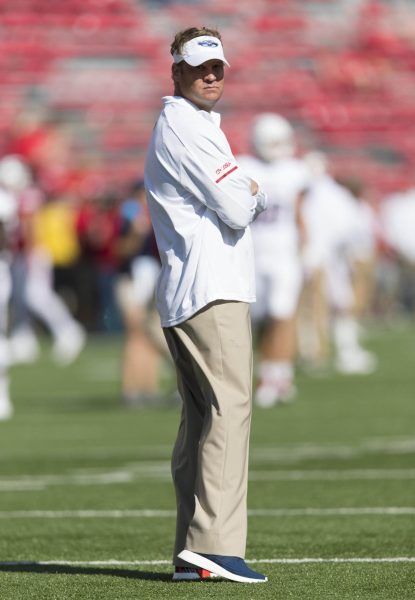
This period of success brought two championships to FAU, multiple NFL draftees and the most wins in a three-year span with 27. Head coach Lane Kiffin was the man behind this success.
Staller said John Kelly, the university president at the time, “really wanted him [Kiffin] bad,” while the athletic director did not. However, Kiffin was able to prove his worth immediately.
In Kiffin’s first year, he turned the program around, going 11-3 and winning their first C-USA championship against North Texas 41-17.
FAU faced North Texas twice this season. After beating North Texas the first time, Staller remembers their head coach Seth Littrell calling FAU’s win a fluke. “We get into the conference championship game, it’s North Texas again,” Staller said. “We killed them again.”
Running back Devin Singletary was the foundation of this proficient offense. He had the best statistical season by any running back and offensive weapon in FAU football history totaling 1,920 rushing yards and 32 rushing touchdowns on 6.4 yards per carry. The Buffalo Bills eventually drafted Singletary in 2019 and he has been an NFL starter since.
FAU severely regressed in 2018 as they posted a record of only 5-7.
“Lane, sitting in his office after the game looking at the stat sheet, going ‘Oh my god, a five-win season, I’ve never had this before,’” LaVicka said. “Like, he was legitimately stunned that had happened.”
The following year, however, things got back on track when FAU won another conference championship and obtained an 11-3 record.
Rumors started to fly toward the end of the 2019 season that Kiffin would leave FAU to be the head coach at a bigger school. He eventually took a job at the University of Mississippi (Ole Miss).
“Lane walks in the locker room after the game,” LaVicka said. “Lane walks in, he says, ‘Guys, I love you, you know this is a business, this is nothing personal. I’ve had an opportunity, though. I‘ve had to make a business decision. I’m going to become Ole Miss’s head coach.’”
Following the 2019 season, FAU hired Willie Taggart. He was previously the head coach for Florida State University, but was let go due to his disappointing 9-12 record with the Seminoles.. The Taggart-led football team went 5-4 in 2020 when COVID-19 shortened the season. FAU made it to the Montgomery Bowl, which ended in a 25-10 loss to Memphis.
FAU fired Taggart after two back-to-back 5-7 seasons and decided to go with a proven coach prior to joining the American Athletic Conference (AAC).
The Modern Era
FAU chose Tom Herman, a former head coach at the University of Texas and the University of Houston. In Herman’s first year, the Owls went 4-8 and battled multiple injuries, including former quarterback Casey Thompson who suffered a season-ending ACL injury.
Wide receiver LaJohntay Wester stood out in the 2023 season. He produced 1,168 receiving yards and eight touchdowns on 108 receptions, one of the best statistical seasons by a receiver in FAU history. He transferred to Colorado leaving as FAU’s all-time leading receiver with 2,703 receiving yards, 21 touchdowns and 252 receptions.
“LaJohntay immediately showed flashes of that speed, of being a dynamic offensive asset,” LaVicka said. “It was not really surprising — his ascension at FAU and the level of importance that he ended up accruing as the top element, the top target, of the FAU offense.”
FAU football has come a long way from its bare-bones beginnings, with no reputation, postseason success or even an on-campus stadium. Now, they’ve accomplished all of those goals. Herman looks to continue Schnellenberger’s vision for FAU football for the foreseeable future.
Morgan Larkins is a Staff Writer for the University Press. Email him at mlarkins2023@fau.edu or DM him on Instagram or Twitter @mj_larkins for more information regarding this or other stories.
















